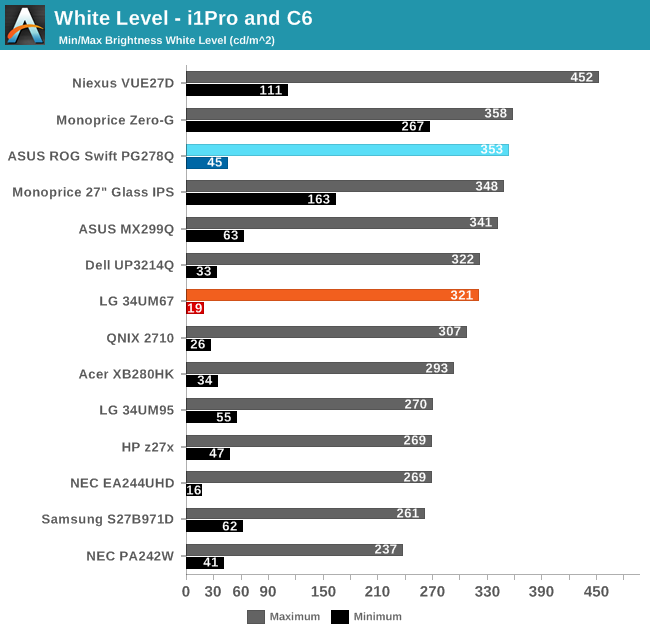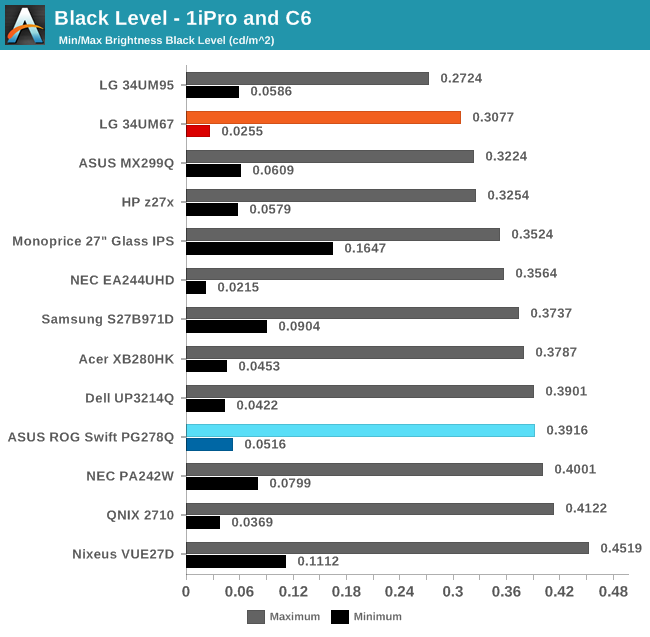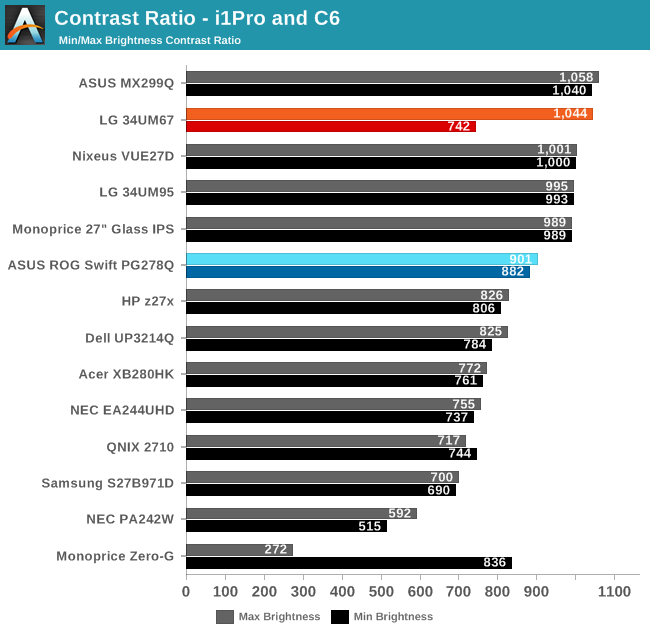LG 34UM67: UltraWide FreeSync Review
by Jarred Walton on March 31, 2015 3:00 PM ESTLG 34UM67 Brightness and Contrast
Moving on from the FreeSync discussion, we still need to see how the LG 34UM67 fares as a display. We’ve run our usual assessments to look at brightness, contrast, color accuracy, and uniformity. We’ll start with the brightness results. The LG FreeSync 34UM67 is in orange/red while we've highlighted the ASUS PG278Q in cyan/blue.

Set to maximum brightness with the default (50/50/50) RGB values, the 34UM67 can output 306 nits, which is just above the rated 300 nits. However, you can increase the output a bit more by maxing out the RGB values at 100, which gives us the above result of 321 cd/m2. This is plenty bright for most people, and more than I would normally need (outside of situations where the display needs to overcome reflections and lights during the day.) Setting the brightness to the minimum level with 50% RGB drops the display to 52 cd/m2, which is perhaps a bit too bright, but if you tweak RGB settings you can get as low as 19 cd/m2. That can work even in very dark rooms, so LG has covered all the necessary output range.

Black levels are okay but nothing amazing. At the maximum backlight (with the OSD Black Stabilizer set to 0 – increasing it will increase black levels somewhat, ostensibly to help you see dark areas in games better), we measured 0.3077 cd/m2. Going to the minimum backlight level this falls down to 0.0255 cd/m2. Interestingly, LG doesn’t appear to be using any form of dynamic contrast, so whether we test with a full screen color or 50% APL patterns makes no difference. That’s a good thing if you’re wondering, as dynamic contrast often ends up being more of a distraction than a benefit (IMO).

The resulting contrast ratios range from just over 1000:1 to closer to 750:1, but the contrast ratio stays pretty consistent until the very lowest brightness settings. Also note that our i1 Pro meter isn’t the most accurate sensor for black levels, so that might contribute to some of the difference. Overall, the contrast ratio is good but not exceptional.










96 Comments
View All Comments
willis936 - Wednesday, April 1, 2015 - link
It's worth mentioning that this wouldn't be good test methodology. Youd be at the mercy of how windows is feeling that day. To test monitor input lag you need to know how long it takes between when a pixel is sent across displayport or whatever to when it is updated on the display. It can be done without "fancy hardware" with a CRT and a high speed camera. Outside of that you'll need to be handling gigabit signals.willis936 - Wednesday, April 1, 2015 - link
Actually it can still be done with inexpensive hardware. I don't have a lot of experience with how low level you can get on the display drivers. Uou would need to find one that has the video transmission specs you want and you could dig into the driver to give out debug times when a frame started being sent (I could be making this unnecessarily complicated in my head, there may be easiest ways to do it). Then you could do a black and white test pattern with a photodiode to get the response time + input lag then some other test patterns to try to work out each of the two components (you'd need to know something about pixel decay and things I'm not an expert on).All of the embedded systems I know of are vga or hdmi though...
Murloc - Wednesday, April 1, 2015 - link
I saw some time ago that some company sold an affordable FPGA development board with video output.Maybe that would work.
Soulwager - Wednesday, April 1, 2015 - link
You can still calibrate with a CRT, but you can get thousands of times more samples than with a high speed camera(with the same amount of effort). USB polling variance is very easy to account for with this much data, so you can pretty easily get ~100 microsecond resolution.willis936 - Wednesday, April 1, 2015 - link
100 microsecond resolution is definitely good enough for monitor input lag testing. I won't believe you can get that by putting mouse input into a black box until I see it. It's not just windows. There's a whole lot of things between the mouse and the screen. anandtech did a decent article on it a few years back.http://www.anandtech.com/show/2803/7
Soulwager - Thursday, April 2, 2015 - link
Games are complicated, but you can make a test program as simple as you want, all you really need to do is go from dark to light when you give an input. And the microcontroller is measuring the timestamps at both ends of the chain, so if there's an inconsistency you haven't accounted for, you'll notice it.AnnonymousCoward - Friday, April 3, 2015 - link
If Windows adds unpredictable delays, all you need to do is take enough samples and trials and compare averages. That's a cool thing about probability.Ryan Smith - Wednesday, April 1, 2015 - link
CRTs aren't a real option here unfortunately. You can't mirror a 4K LCD to a CRT, and any additional processing will throw off the calculations.invinciblegod - Tuesday, March 31, 2015 - link
Having proprietary standards in pc gaming accessories is extremely frustrating. I switch between AMD and nVidia every other generation or so and I would hate for my monitor to be "downgraded" because I bought the wrong graphics card. I guess the only solution here is to pray for nVidia to support Adaptive-Sync so that we can all focus on one standard.invinciblegod - Tuesday, March 31, 2015 - link
I assume you didn't encounter supposed horrible backlight bleed that people seem to complain about on forums. That (and the currently proprietary nature of freesync until intel or nvidia supports it) is preventing me from buying this monitor.